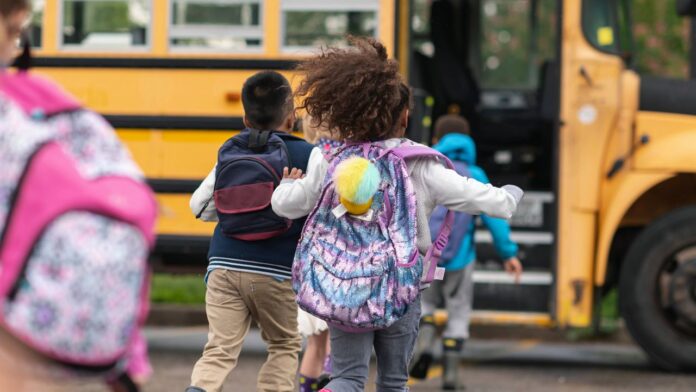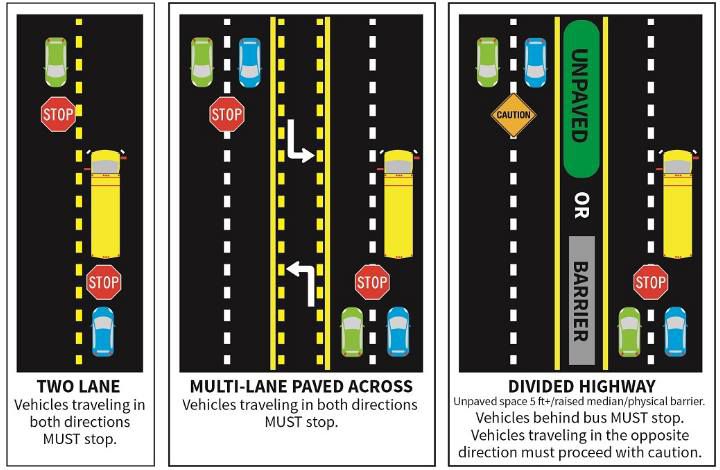TAMPA, Fla. — The Florida Department of Highway Safety and Motor Vehicles (FLHSMV) and AAA are reminding drivers to remain alert around schools and buses as the 2023-24 school season begins.
What You Need To Know
- As back-to-school season gets underway, the Florida Department of Highway Safety and Motor Vehicles (FLHSMV) and AAA advise motorists to use caution around school buses and in school zones and neighborhoods
- Some penalties have doubled for failing to stop for school buses
- FLHMSV and AAA also provided additional safety tips for parents and children
With the start of the new school year, about 2.8 million students in Florida are preparing to go to classes, and the combination of young, inexperienced drivers, pedestrians and bicyclists who will all share the road in the early-morning and afternoon hours is particularly dangerous, AAA said.
According to the National Highway Traffic Safety Administration, 64% of child pedestrians killed in traffic crashes occurred during the weekday (6 a.m. Monday to 6 p.m. Friday) in 2021.
Nearly one in four fatal crashes involving teen drivers in the United States occurs during the after-school hours of 3 p.m. to 7 p.m., AAA reported.
“Drivers can save lives by having a heightened sense of awareness from the moment they leave the driveway,” AAA spokesperson Mark Jenkins said. “You’d expect to see more foot traffic near schools, but neighborhoods and city streets will also be bustling with activity. Since children can move quickly and cross the road unexpectedly, it’s important to constantly scan the road for people while driving and be ready to stop at a moment’s notice.”
In 2022, almost 3,000 crashes involved school buses, according to the FLHSMV. The penalties for failing to stop for a school bus and passing a stopped school bus on the side where children enter and exit have doubled as of Jan. 1 2021.
In a recent AAA survey, 38% of drivers admitted to speeding and 31% conceded that they used a hand-held cell phone in active school zones.
FLHSMV said drivers need to pay extra attention to lower speed limits, watch for and obey signals from school crossing guards and to only drive or park in authorized areas to pick up or drop off kids at school. Parents are also encouraged to go over safety tips with their children to make sure they are safe around school buses and school zones.
(Courtesy of FLHSMV)
Motorists are required to stop when approaching a school bus that is stopped with its red lights flashing and STOP arms extended. Other rules about navigating areas near school buses include:
- On two-lane roads, all drivers moving in either direction on a two-way street must stop for a school bus displaying a stop signal, and must remain stopped until the road is clear of children and the school bus stop arm is withdrawn.
- On a highway divided by a paved median, all drivers moving in either direction must stop for a school bus displaying a stop signal and must remain stopped until the road is clear of children and the school bus stop arm is withdrawn.
- Divided highways, where there is a raised barrier such as a concrete divider or at least 5 feet of unpaved space separating the lanes of traffic, are the only roadways where traffic approaching an oncoming school bus does not need to stop. On a highway divided by a raised barrier or an unpaved median at least 5 feet wide, drivers moving in the opposite direction do not have to stop for the bus (painted lines or pavement markings are not considered barriers). However, these motorists should slow down and watch for students loading or unloading from the bus.
Penalties for passing a stopped school bus include a moving violation to citation, a requirement to complete a basic driver improvement course upon conviction, four points on your driver’s license and a minimum fine of $165. Motorists who pass on the side where children enter and exi will receive a minimum fine of $265.
If a driver passes a school bus and causes serious bodily injury or death of another person, penalties include serving 120 community service hours in a trauma center or hospital, participating in a victim’s impact panel session (or if such a panel does not exist, attending a FLHSMV-approved driver improvement course), six points on your driver’s license, suspension of your license for a minimum of one year and a $1,500 fine.
🚌 With school buses back on the roads today, some good reminders of when to stop! Drive safe! @BN9 pic.twitter.com/2JXWwzYAue
— Tim Wronka (@TimWronka) August 10, 2023
FLHSMV and AAA provide additional school safety tips for parents and their children.
For drivers:
- Slow down.
- Come to a complete stop at stop signs in school zones or neighborhoods, and check carefully for children on sidewalks and in crosswalks before proceeding.
- Keep your eyes on the road.
- Slow down and allow at least 3 feet of passing distance between your vehicle and a bicyclist.
For pedestrians:
- Pay attention at all times. Avoid texting or wearing headphones, so you can detect nearby traffic.
- Use sidewalks where available. If not, walk against the direction of traffic so you can see oncoming vehicles.
- Make yourself easier to be seen by wearing reflective, bright-colored clothing.
For bicyclists:
- Wear a helmet and neon or bright-colored clothes.
- Ride in the same direction as traffic and stay as far to the right as possible. Use bike lanes when you can.
- Do not wear headphones so you can detect approaching traffic.
- Cross the street at intersections. Do not pull into the roadway from between parked cars.
On and around school buses:
- Arrive at the bus stop about five minutes before the bus is scheduled to arrive.
- At bus stops, children should wait five steps away from the curb. Never sit on the roadway or curb while waiting for the bus.
- Be alert and remove headphones so you can hear oncoming traffic.
- Make sure children know their bus driver’s name and bus number.
- Tell children to never speak to strangers at the bus stop or get into the car with a stranger. Children should tell parents, the bus driver and a teacher at school if a stranger tries to talk to them or pick them up.
- Children should never walk behind a bus and should stay away from bus wheels at all times. When the bus stops, children should wait for the driver’s signal that it is safe to cross the road or board the bus.
- Children should look both ways before crossing the street- look left, right and left again. They should make eye contact to make sure the bus driver can see them as they cross the street.
- On the bus, children should remain seated at all times, keep the aisle clear and not put their head, hands or arms out the window.
- Children should stop talking and remain silent when the bus comes to a railroad crossing so the driver can hear if a train is approaching.
- Children should avoid any loud or disruptive behavior that could distract the bus driver from safely operating the bus.
- Refer to the official Florida Driver License Handbook for more information on school bus safety.















